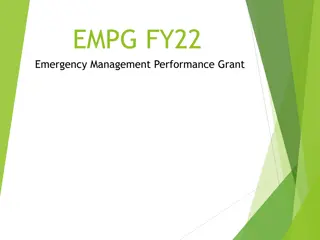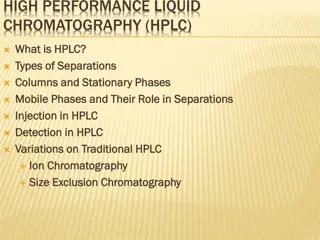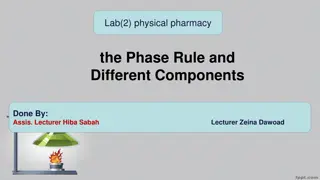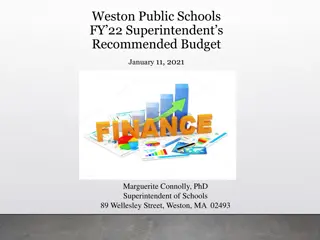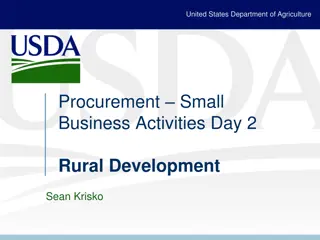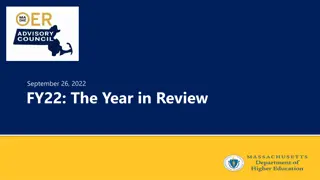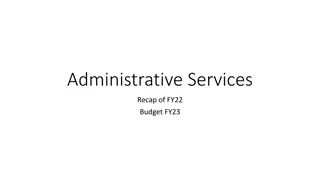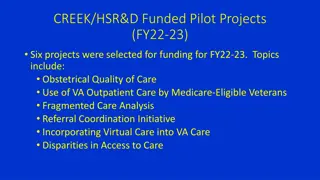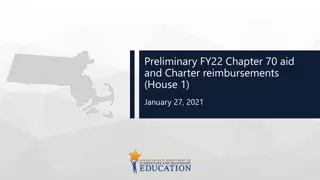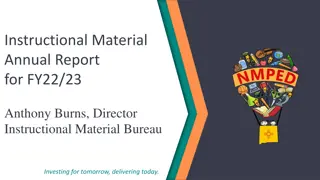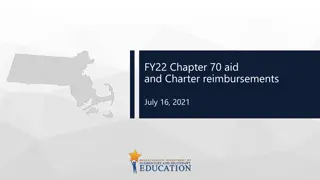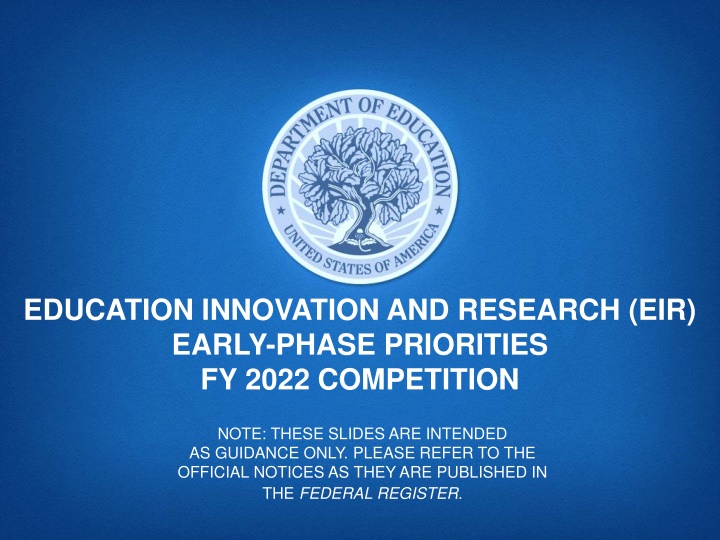
Early-Phase Priorities in Education Innovation and Research 2022 Competition
Explore the absolute priorities and early-phase absolute priorities for the Education Innovation and Research (EIR) competition in fiscal year 2022. The focus is on promoting equity, student access to educational resources, and implementing field-initiated innovations to enhance student achievement. Applicants must address specific criteria and select one priority to target in their projects.
Download Presentation

Please find below an Image/Link to download the presentation.
The content on the website is provided AS IS for your information and personal use only. It may not be sold, licensed, or shared on other websites without obtaining consent from the author. If you encounter any issues during the download, it is possible that the publisher has removed the file from their server.
You are allowed to download the files provided on this website for personal or commercial use, subject to the condition that they are used lawfully. All files are the property of their respective owners.
The content on the website is provided AS IS for your information and personal use only. It may not be sold, licensed, or shared on other websites without obtaining consent from the author.
E N D
Presentation Transcript
EDUCATION INNOVATION AND RESEARCH (EIR) EARLY-PHASE PRIORITIES FY 2022 COMPETITION NOTE: THESE SLIDES ARE INTENDED AS GUIDANCE ONLY. PLEASE REFER TO THE OFFICIAL NOTICES AS THEY ARE PUBLISHED IN THE FEDERAL REGISTER.
ABSOLUTE PRIORITIES All Early-phase applicants must address this evidence priority. Absolute Priority (AP) 1: Demonstrates a Rationale: Demonstrates a rationale means a key project component included in the project s logic model is informed by research or evaluation findings that suggest the project component is likely to improve relevant outcomes. 2
ABSOLUTE PRIORITIES (CONT.) Early-phase applicants must select one of the absolute priorities listed below. Applicants must clearly indicate which one in their abstract and project narrative. Absolute Priority 2: Field-Initiated Innovations General Absolute Priority 3: Field-Initiated Innovations Promoting Equity in Student Access to Educational Resources and Opportunities: STEM Absolute Priority 4: Field-Initiated Innovations Meeting Student Social, Emotional, and Academic Needs 3
EARLY-PHASE ABSOLUTE PRIORITY 2 Field-initiated innovations General Projects that are designed to create, develop, implement, replicate, or take to scale entrepreneurial, evidence-based, field-initiated innovations to improve student achievement and attainment for high-need students. 4
EARLY-PHASE ABSOLUTE PRIORITY 3 Field-initiated innovations -- Promoting Equity in Student Access to Educational Resources and Opportunities: STEM Under the priority, we provide funding to projects that are designed to: (a) Create, develop, implement, replicate, or take to scale entrepreneurial, evidence- based, field-initiated innovations to improve student achievement and attainment for high- need students; and (b) Promote educational equity and adequacy in resources and opportunity for underserved students (1) In one or more of the following educational settings: (i) Early learning programs. (ii) Elementary school. (iii) Middle school. (iv) High school. (v) Career and technical education programs. (vi) Out-of-school-time settings. (vii) Alternative schools and programs. (viii) Juvenile justice system or correctional facilities;(2) That examine the sources of inequity and inadequacy and implement responses, including rigorous, engaging, and well-rounded (e.g., that include music and the arts) approaches to learning that are inclusive with regard to race, ethnicity, culture, language, and disability status and prepare students for college, career, and civic life, including science, technology, engineering, and mathematics (STEM), including computer science coursework. 5
EARLY-PHASE ABSOLUTE PRIORITY 4 Field-initiated innovations -- Meeting Student Social, Emotional, and Academic Needs Projects that are designed to-- a) Create, develop, implement, replicate, or take to scale entrepreneurial, evidence-based, field-initiated innovations to improve student achievement and attainment for high-need students; and b) Improve students social, emotional, academic, and career development, with a focus on underserved students through one or more of the following priority areas: 6
EARLY-PHASE ABSOLUTE PRIORITY 4 Field-initiated innovations -- Meeting Student Social, Emotional, and Academic Needs Cont. (1) Developing and supporting educator and school capacity to support social and emotional learning and development that-- (i) Fosters skills and behaviors that enable academic progress; (ii) Identifies and addresses conditions in the learning environment, that may negatively impact social and emotional well-being for underserved students, including conditions that affect physical safety; and (iii) Is trauma-informed, such as addressing exposure to community-based violence and trauma specific to military- or veteran-connected students (as defined in this notice). 7
EARLY-PHASE ABSOLUTE PRIORITY 4 Field-initiated innovations -- Meeting Student Social, Emotional, and Academic Needs Cont. (2) Creating education or work-based settings that are supportive, positive, identity-safe and inclusive with regard to race, ethnicity, culture, language, and disability status, through one or more of the following activities: (i) Developing trusting relationships between students (including underserved students), educators, families, and community partners. (ii) Providing high-quality professional development opportunities designed to increase engagement and belonging and build asset- based mindsets for educators working in and throughout schools. (iii) Engaging students (including underserved students), educators, families, and community partners from diverse backgrounds and representative of the community as partners in school climate review and improvement efforts. 8
EARLY-PHASE ABSOLUTE PRIORITY 4 Field-initiated innovations -- Meeting Student Social, Emotional, and Academic Needs Cont. (iv) Developing and implementing inclusive and culturally informed discipline policies and addressing disparities in school discipline policy by identifying and addressing the root causes of those disparities, including by involving educators, students, and families in decision-making about discipline procedures and providing training and resources to educators. (v) Supporting students to engage in real-world, hands-on learning that is aligned with classroom instruction and takes place in community-based settings, such as apprenticeships, pre- apprenticeships, work-based learning, and service learning, and in civic activities, that allow students to apply their knowledge and skills, strengthen their employability skills, and access career exploration opportunities. 9
EARLY-PHASE ABSOLUTE PRIORITY 4 Field-initiated innovations -- Meeting Student Social, Emotional, and Academic Needs Cont. (3) Providing multi-tiered systems of supports that address learning barriers both in and out of the classroom, that enable healthy development and respond to students needs and which may include evidence-based trauma-informed practices and professional development for educators on avoiding deficit-based approaches. (4) Developing or implementing policies and practices, consistent with applicable Federal law, that prevent or reduce significant disproportionality on the basis of race or ethnicity with respect to the identification, placement, and disciplining of children or students with disabilities (as defined in this notice). (5) Providing students equitable access that is inclusive, with regard to race, LGBTQI+, ethnicity, culture, language, and disability status, to social workers, psychologists, counselors, nurses, or mental health professionals and other integrated services and supports, which may include in early learning environments. 10
EARLY-PHASE ABSOLUTE PRIORITY 4 Field-initiated innovations -- Meeting Student Social, Emotional, and Academic Needs Cont. (6) Preparing educators to implement project-based or experiential learning opportunities for students to strengthen their metacognitive skills, self-direction, self-efficacy, competency, or motivation, including through instruction that: Connects to students prior knowledge and experience; provides rich, engaging, complex, and motivating tasks; and offers opportunities for collaborative learning. (7) Creating and implementing comprehensive schoolwide frameworks (such as small schools or learning communities, advisory systems, or looping educators) that support strong and consistent student and educator relationships. (8) Fostering partnerships, including across government agencies (e.g., housing, human services, employment agencies), local educational agencies, community-based organizations, adult learning providers, and postsecondary education intuitions, to provide comprehensive services to students and families that support students social, emotional, mental health, and academic needs, and that are inclusive with regard to race, ethnicity, culture, language, and disability status. 11
COMPETITIVE PREFERENCE PRIORITIES Applicants have the option of addressing one or more of the Competitive Preference Priorities, regardless of which absolute priority they select Competitive Preference Priority 1: Competitive Preference Priority 2: Promoting Equity in Student Access to Educational Resources and Opportunities Addressing the Impact of COVID 19 on Students, Educators, and Faculty 12
COMPETITIVE PREFERENCE PRIORITY 1-- Promoting Equity in Student Access to Educational Resources and Opportunities Projects designed to promote educational equity and adequacy in resources and opportunity for underserved students in middle school or high school that examine the sources of inequity and inadequacy and implement responses, including rigorous, engaging, and well-rounded (e.g., that include music and the arts) approaches to learning that are inclusive with regard to race, ethnicity, culture, language, and disability status and prepare students for college, career, and civic life, including one or more of the following: (a) Student-centered learning models that may leverage technology to address learner variability (e.g., universal design for learning (as defined in this notice), K 12 competency-based education (as defined in this notice), project-based learning, or hybrid/blended learning) and provide high-quality learning content, applications, or tools. (b) Middle school courses or projects that prepare students to participate in advanced coursework in high school. (c) Advanced courses and programs, including dual enrollment and early college programs. (d) Project-based and experiential learning, including service and work-based learning. (e) High-quality career and technical education courses, pathways, and industry- recognized credentials that are integrated into the curriculum. 13
COMPETITIVE PREFERENCE PRIORITY 2-- Addressing the Impact of COVID 19 on Students, Educators, and Faculty Projects that are designed to address the impacts of the COVID 19 pandemic, including impacts that extend beyond the duration of the pandemic itself, on the students most impacted by the pandemic, with a focus on underserved students and the educators who serve them through-- (a) Conducting community asset-mapping and needs assessments that may include an assessment of the extent to which students, including subgroups of students, have become disengaged from learning, including students not participating in in-person or remote instruction, and specific strategies for reengaging and supporting students and their families; and (b) Using evidence-based instructional approaches and supports, such as professional development, coaching, ongoing support for educators, high quality tutoring, expanded access to rigorous coursework and content across K 12, and expanded learning time to accelerate learning for students in ways that ensure all students have the opportunity to successfully meet challenging academic content standards without contributing to tracking or remedial courses. 14
WHAT IS A LOGIC MODEL? Logic model (also referred to as a theory of action) means a framework that identifies key project components of the proposed project (i.e., the active ingredients that are hypothesized to be critical to achieving the relevant outcomes) and describes the theoretical and operational relationships among the key project components and relevant outcomes. 15
SAMPLE LOGIC MODEL Source: REL Pacific see link on next slide. 16
LOGIC MODEL RESOURCES Education Logic Model (ELM) Application (REL Pacific) Logic models: A tool for effective program planning, collaboration, and monitoring (REL Pacific) Logic models: A tool for designing and monitoring program evaluations (REL Pacific) Logic models for program design, implementation, and evaluation: Workshop toolkit (REL Northeast and Islands) 17
THANK YOU! EIR EMAIL: EIR@ED.GOV EIR PHONE: (202) 453-7122

